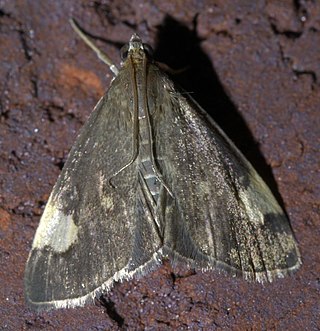
Hahncappsia is a genus of moths of the family Crambidae, and the order Lepidoptera.

Raphia frater, the brother moth or simply the brother, is a moth of the family Noctuidae. It is found from Nova Scotia west, across the forested regions of Canada to British Columbia, south to Mississippi in the east. The southern limits in the west are uncertain due to confusion with several closely related species or forms.

Selenia kentaria, commonly known as Kent's thorn or Kent's geometer, is a moth of the family Geometridae. The species was first described by Augustus Radcliffe Grote and Coleman Townsend Robinson in 1867. It is found in eastern and central North America.

Euphyes bimacula, the two-spotted skipper, is a butterfly of the family Hesperiidae. It is found in North America, from northeast Colorado and western Nebraska; eastern Nebraska east to southern Quebec; southern Maine south to central Virginia; coastal plain south to Georgia; and the Gulf Coast.
Prodoxus coloradensis is a moth of the family Prodoxidae. In North America it is found from the Colorado Plateau in the north to northern Sonora in the south, east to the Big Bend region of Texas and west to the coastal range of southern California.
Pseudocharis minima, the lesser wasp moth, is a moth in the subfamily Arctiinae. It was described by Augustus Radcliffe Grote in 1867. It is found on Cuba and in Florida. The habitat consists of pine rocklands, tropical hammocks and the ecotone between hammocks and salt marshes.

Evergestis unimacula, the large-spotted evergestis moth, is a moth in the family Crambidae. It was described by Augustus Radcliffe Grote and Coleman Townsend Robinson in 1867. It is found in North America, where it has been recorded from Georgia, Illinois, Indiana, Iowa, Maryland, Michigan, North Carolina, Ohio, Oklahoma, Ontario, Pennsylvania, Quebec, Tennessee and West Virginia. Outliers have been recorded from Florida.
Hahncappsia ecuadoralis is a moth in the family Crambidae described by Hahn William Capps in 1967. It is found in Peru, Ecuador and Bolivia.
Hahncappsia volcanensis is a moth in the family Crambidae described by Hahn William Capps in 1967. It is found in Guatemala, Costa Rica and Venezuela.
Hahncappsia conisphora is a moth in the family Crambidae. It was described by George Hampson in 1913. It is found in Guatemala, Costa Rica and Mexico.
Hahncappsia jaralis is a moth in the family Crambidae. It was described by William Schaus in 1920. It is found in the United States in southern Arizona and in Mexico in Oaxaca, Puebla, Jalisco and San Luis Potosí.

Hahncappsia marculenta is a moth in the family Crambidae. It was described by Augustus Radcliffe Grote and Coleman Townsend Robinson in 1867. It is found in North America, where it is widespread east of the Rocky Mountains.

Hahncappsia mellinialis is a moth in the family Crambidae. It was described by Herbert Druce in 1899. It is found in Colorado, Arizona, New Mexico, Mexico and Guatemala.

Hahncappsia pergilvalis is a moth in the family Crambidae. It was described by George Duryea Hulst in 1886. It is found in North America, where it has been recorded from Ontario and the north-eastern and south-western United States. It is also present in Mexico, where it has been recorded from the Federal District, Puebla and Jalisco.
Loxostege anartalis is a moth in the family Crambidae. It was described by Augustus Radcliffe Grote in 1878. It is found in North America, where it has been recorded from coast to coast in Canada. In the west, the range extends south to California.

Pyrausta generosa is a moth in the family Crambidae. It was described by Augustus Radcliffe Grote and Coleman Townsend Robinson in 1867. It is found in North America, where it has been recorded from Ontario to Alberta and to Florida and Missouri. The habitat consists of undisturbed areas in aspen parkland and mixed woods.

Pyrausta lethalis, the lethal pyrausta moth, is a moth in the family Crambidae. It was described by Augustus Radcliffe Grote in 1881. It is found in North America, where it has been recorded from California to southern Nevada, southern Arizona and Texas.

Diacme adipaloides, the darker diacme moth, is a moth in the family Crambidae. It was described by Augustus Radcliffe Grote and Coleman Townsend Robinson in 1867. It is found in North America, where it has been recorded from Alabama, Arkansas, Florida, Indiana, Maine, Maryland, Massachusetts, Michigan, Minnesota, New Brunswick, New Hampshire, New Jersey, New York, North Carolina, Nova Scotia, Ohio, Oklahoma, Ontario, Quebec, South Carolina, Tennessee, Texas, Virginia, West Virginia and Wisconsin. Adults have been recorded year round.

Baileya australis, the small baileya moth, is a moth of the family Nolidae. The species was first described by Augustus Radcliffe Grote in 1881. It is found in North America, where it has been recorded from Quebec and New York to Florida, west to Texas, north to North Dakota and Ontario.

Ecliptopera atricolorata, the dark-banded geometer moth, is a moth of the family Geometridae. It is found in North America, where it has been recorded from Alabama, Arkansas, Florida, Georgia, Indiana, Kentucky, Maryland, Mississippi, North Carolina, Ohio, Pennsylvania, South Carolina, Tennessee, Virginia and West Virginia.












